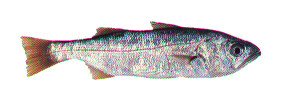Queenfish
Queenfish (Seriphus politus) is a species of fish belonging to the family Sciaenidae, commonly known as the croakers or drum fish. This species is native to the eastern Pacific Ocean, ranging from the coast of California to the Gulf of California. Queenfish are important both to commercial and recreational fisheries, especially in the southern part of their range.
Description[edit | edit source]
Queenfish are medium-sized fish, typically reaching lengths of up to 60 cm (24 in), though larger specimens have been recorded. They have elongated bodies with a silvery sheen, often exhibiting a bluish tint on the back. The fish is distinguished by its highly forked tail and a prominent lateral line that runs along the length of its body. The mouth is equipped with small, sharp teeth, and the jaw extends to below the eye.
Habitat and Behavior[edit | edit source]
Queenfish inhabit coastal waters, often found over sandy or muddy bottoms. They are known to form large schools, especially during their spawning season in the summer months. Their diet primarily consists of small fish, crustaceans, and cephalopods.
Juvenile queenfish are often found in shallower waters, including bays and estuaries, where they are more protected from predators. As they mature, they tend to move to deeper offshore waters, although they remain relatively close to the coast.
Reproduction[edit | edit source]
The reproduction of queenfish involves spawning that occurs in the warmer months, from late spring through summer. Females release thousands of eggs into the water, which are then fertilized externally by the males. The eggs are pelagic, meaning they float freely in the water column until hatching. Larvae and juvenile queenfish are subject to high predation rates and rely on coastal habitats for shelter and food.
Fishing and Conservation[edit | edit source]
Queenfish are a popular target for both commercial and recreational fishers due to their fighting ability and taste. They are primarily caught using hook and line methods. In some areas, their populations are monitored to prevent overfishing and ensure sustainable fisheries.
While queenfish are not currently listed as endangered or threatened, their dependence on coastal habitats makes them vulnerable to habitat degradation and pollution. Efforts to preserve coastal and estuarine environments are crucial for the continued health of queenfish populations.
Culinary Uses[edit | edit source]
In regions where they are caught, queenfish are considered a good eating fish. They can be prepared in various ways, including grilling, frying, and baking. The flesh is light and flaky, with a mild flavor that is appreciated by many.
| This article is a stub. You can help WikiMD by registering to expand it. |
Search WikiMD
Ad.Tired of being Overweight? Try W8MD's physician weight loss program.
Semaglutide (Ozempic / Wegovy and Tirzepatide (Mounjaro / Zepbound) available.
Advertise on WikiMD
|
WikiMD's Wellness Encyclopedia |
| Let Food Be Thy Medicine Medicine Thy Food - Hippocrates |
Translate this page: - East Asian
中文,
日本,
한국어,
South Asian
हिन्दी,
தமிழ்,
తెలుగు,
Urdu,
ಕನ್ನಡ,
Southeast Asian
Indonesian,
Vietnamese,
Thai,
မြန်မာဘာသာ,
বাংলা
European
español,
Deutsch,
français,
Greek,
português do Brasil,
polski,
română,
русский,
Nederlands,
norsk,
svenska,
suomi,
Italian
Middle Eastern & African
عربى,
Turkish,
Persian,
Hebrew,
Afrikaans,
isiZulu,
Kiswahili,
Other
Bulgarian,
Hungarian,
Czech,
Swedish,
മലയാളം,
मराठी,
ਪੰਜਾਬੀ,
ગુજરાતી,
Portuguese,
Ukrainian
Medical Disclaimer: WikiMD is not a substitute for professional medical advice. The information on WikiMD is provided as an information resource only, may be incorrect, outdated or misleading, and is not to be used or relied on for any diagnostic or treatment purposes. Please consult your health care provider before making any healthcare decisions or for guidance about a specific medical condition. WikiMD expressly disclaims responsibility, and shall have no liability, for any damages, loss, injury, or liability whatsoever suffered as a result of your reliance on the information contained in this site. By visiting this site you agree to the foregoing terms and conditions, which may from time to time be changed or supplemented by WikiMD. If you do not agree to the foregoing terms and conditions, you should not enter or use this site. See full disclaimer.
Credits:Most images are courtesy of Wikimedia commons, and templates Wikipedia, licensed under CC BY SA or similar.
Contributors: Prab R. Tumpati, MD


